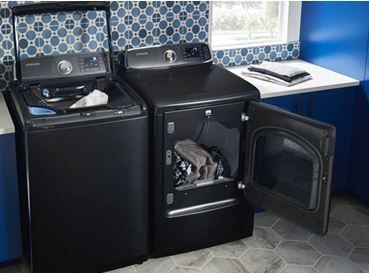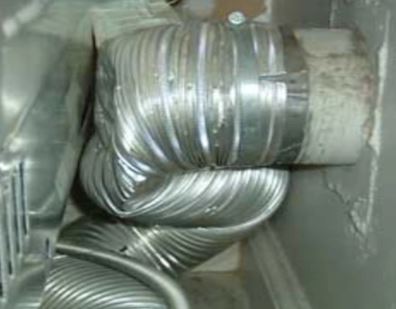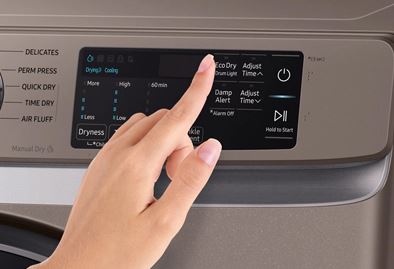Samsung vent sensor dryers are amongst Samsung’s smartest dryers because of their built-in vent check sensors. Their effectiveness, however, depends on your ability to tell when the sensor is trying to communicate a vent blockage to you, and that’s where this Samsung Vent Sensor Dryer troubleshooting manual comes in.
With it, you can troubleshoot your Samsung vent sensor dryer when the sensor light comes on or starts to blink and when the dryer won’t get hot or fails to dry your clothes. What’s more, you can troubleshoot vent-related display symbols.
But as you’ll realize, there are still other issues that could trigger the above five problems. So, it’s also worth getting familiar with them and their troubleshooting, which I’ll also cover.
Before that, you may need to do a vent blockage test to tell if the vent is blocked. But first things first, let me help you understand what a vent sensor is on your dryer.

In a hurry? Below is a simple guide to troubleshooting a Samsung vent sensor dryer:
Quick Samsung Vent Sensor Dryer Troubleshooting Manual
| – | Problem | Likely Reason | What to Do |
| 1. | Vent Sensor Light Comes On | Up to 60% exhaust vent blockage | Clean/unkink the exhaust vent |
| 2. | Vent Sensor Light Blinking | Up to 80% exhaust vent blockage | Clean/unkink the exhaust vent |
| 3. | Dryer Won’t Heat | Vent or lint screen blockage, wrong setting, failed power supply, or burnt heating element. | Unblock the exhaust vent or lint filter, choose the correct cycle setting, ensure the dryer has power, and replace a burnt heating element. |
| 4. | Dryer Won’t Dry Clothes | Vent or lint screen blockage, wrong cycle, dryer overload, unbalanced load, failed power supply, clogged blower, or filthy moisture sensor. | Unblock the exhaust vent or lint filter, choose the appropriate cycle, don’t overload the dryer, evenly distribute the wet laundry, ensure the dryer has power, and wipe the moisture sensor with a soft cloth. |
| 5. | Vent Sensor Dryer Symbols (Filter Reminder and Vent Check symbols) | Blocked lint filter or vent | Clean the lint filter and exhaust vent if they are dirt-obstructed |
What Is Vent Sensor On Samsung Dryer?
Some Samsung dryer models have a ‘vent check sensor’ feature that detects an exhaust vent obstruction. When they do, the vent sensor light may come on and stay solid or start blinking during a cycle.
That’s a sign that you should inspect the exhaust vent for blockage and clear it. However, before anything, you may want to perform a vent blockage test to determine if the vent is blocked before taking down the dryer.
Samsung Dryer Vent Sensor Test
By performing the Samsung dryer vent blockage test, you can determine if your vent is really blocked. Here are the steps for doing it:
- Wait for the dryer to cool down if it is running
- Empty the dryer (remove all clothes) and shut its door to obtain accurate results
- Power on the dryer and press these key combinations within 5 minutes: Time Up + Dry Level, Cycle + Wrinkle Prevent, or Air-Fluff + Wrinkle Prevent.
- Wait for the dryer to run the vent blockage test and display the results – this may take up to 2 minutes.
Results Interpretation
The display will read End or 0 if there’s no vent blockage. However, if there’s vent blockage, the display will show Clg, Cl9, C8, C80, C9, or C90, depending on the level of blockage.
You can expect the error code C9, Cl9, or C90 if the exhaust vent is 90% blocked and C8 or C80 if it’s 80% clogged.

Common Samsung Vent Sensor Dryer Problems
Generally, here are some common issues associated with a Samsung dryer vent blockage:
1. Samsung Dryer Vent Sensor Light On
Expect your Samsung dryer’s vent sensor light to come on during a dry cycle when the exhaust vent is about 60% blocked. While this usually is not a serious sign, it shows you should inspect the dryer vent and possibly clean it before it becomes heavily clogged.
If you don’t, your dryer may have trouble getting hot or drying the clothes, as I’ll explain later.
Fix
Inspect the exhaust vent for blockage and clean it if it’s dirt-clogged. But if it’s not, check it for kinking and straighten it out. Remember, you can clean the vent with a vacuum cleaner or a duct-cleaning kit.
2. Samsung Dryer Vent Sensor Light Blinking
Once the exhaust vent becomes excessively clogged, about 80% blocked, the vent sensor light blinks and may continue for up to 3 hours. During this time, your dryer takes too long to get hot and will likely fail to dry the clothes.
Nonetheless, a few other issues besides an obstructed exhaust vent could trigger the blinking light. We are talking about the following:
- Clogged lint screen – The lint screen could also over-accumulate lint, and the blockage could end up restricting airflow. Once that happens, the vent sensor light might start blinking continuously.
- Large load size – If the load size is too big, the dryer may try to communicate to you by blinking the vent sensor light or any other indicator.
Fix
First, try to reset your Samsung dryer vent sensor, and here’s how to quickly perform the Samsung dryer vent sensor reset:
- Power off the dryer
- Pull it out of the power socket for at least 5 minutes to allow it to clear out electric charges.
- Plug the dryer back in and power it on
- Wait to see if the dryer vent indicator will continue blinking
If the indicator continues blinking, check the exhaust vent for blockage and clean or unkink it. You can run the vent blockage test here, and if it’s negative, inspect the lint screen, clean it, and ensure the load size isn’t too big.
3. Samsung Vent Sensor Dryer Not Heating
Your Samsung vent sensor dryer won’t get hot if there’s a vent blockage. That’s mainly because the blockage will restrict airflow. So, after the vent indicator light starts blinking, the subsequent likely effect is the dryer failing to get hot.
However, it’s not just a vent blockage that can stop a dryer from getting hot. There are still other issues, which include the following:
- Lint screen blockage – The lint screen could trap excess lint and become blocked. Once that happens, the blockage restricts airflow, which could stop the dryer from getting hot.
- Wrong setting – Some settings don’t allow the dryer to get hot at all, as is the case with Air Fluff. Others, like Perm Press and Eco Dry, only enable it to produce minimal heat that you may not tell quickly.
- Failed power supply – If your dryer doesn’t have power, it won’t get hot. It’s that simple! You may have to check for issues like a tripped breaker, faulty socket, or a disconnected gas supply.
- Burnt heating element – If the heating element gets burnt, which may happen during a power surge, it won’t heat the air in your dryer, and your vent sensor dryer will, therefore, not get hot.
Fix
First, run the vent blockage test to determine if the issue is with the exhaust vent and unblock it. If not, check the setting to ensure it is correct and that the dryer has power. In case the heating element appears burnt out, replace it.

4. Samsung Multisteam Vent Sensor Dryer Not Drying
It’s a no-brainer: your Samsung vent sensor dryer won’t dry clothes if it doesn’t get hot. So, you’ll have to go through the issues shared earlier. They are, however, not the only ones. You may have to consider a few extra ones.
But first, you may have to run the vent blockage test to rule out the possibility of a blocked exhaust vent. Once you do that, you may consider the following issues:
- Lint screen blockage – If the lint screen over-accumulates lint, the clog will restrict airflow, forcing the dryer to take a long time to get hot and dry the clothes.
- Wrong cycle – Some dryer cycle settings take longer than others, especially when drying bulky loads. So, check the dryer settings.
- Dryer overload – If the drum exceeds 75% capacity, the wet clothes may take longer to get hot and dry. Some may not dry at all.
- Unbalanced load – If clothes form heaps in the drum, they will hold water for much longer and may not dry even after the cycle ends.
- Failed power supply – If your vent dryer doesn’t receive sufficient power, it won’t get hot. Yes, it may turn on, but it won’t heat up.
- Clogged blower – The blower traps lint, and once it clogs up, it struggles to draw air out. Once that happens, the dryer takes longer to get hot.
- Filthy moisture sensor – With the moisture detector’s job being to detect the moisture level and stop the dry cycle once the dryer reaches a specific moisture level, it fails to do that when it over-accumulates dirt. The result is that the dryer may fail to dry the clothes.
Fix
Run the vent blockage test and clear any blockage from the exhaust vent. If the exhaust vent is okay, inspect the lint screen and clean it. Also, remove any lint clogging around the blower.
But before you get to that, ensure you use the correct setting, evenly distribute the load, and don’t overload it. Moreover, ensure your dryer has enough power, and if the moisture sensor is filthy, wipe it clean with a piece of cloth.
5. Samsung Vent Sensor Dryer Symbols
If there’s an issue with vent blockage, the dryer may show any of these two display symbols:
- Vent Check – The vent check symbol indicates that you should check the exhaust vent for lint blockage and clean it. If it’s not a blockage, it’s a kink.
- Filter Reminder – The filter reminder symbol shows you should check the lint filter for lint obstruction and clean it.
Important Note:
While cleaning the vent should be the first consideration in case of a vent blockage, sometimes all you should do is replace the vent. So, a Samsung dryer vent sensor replacement should be an option, especially if you can’t clean the vent or it’s too damaged.
Concluding Thought:
Above is a simple Samsung Vent Sensor Dryer troubleshooting guide when the vent sensor light comes on or starts flashing, when the dryer fails to get hot or dry the clothes, or when the dryer displays some vent-related symbols. That should save you time and money if you fix the issue and don’t have to call an expert.
